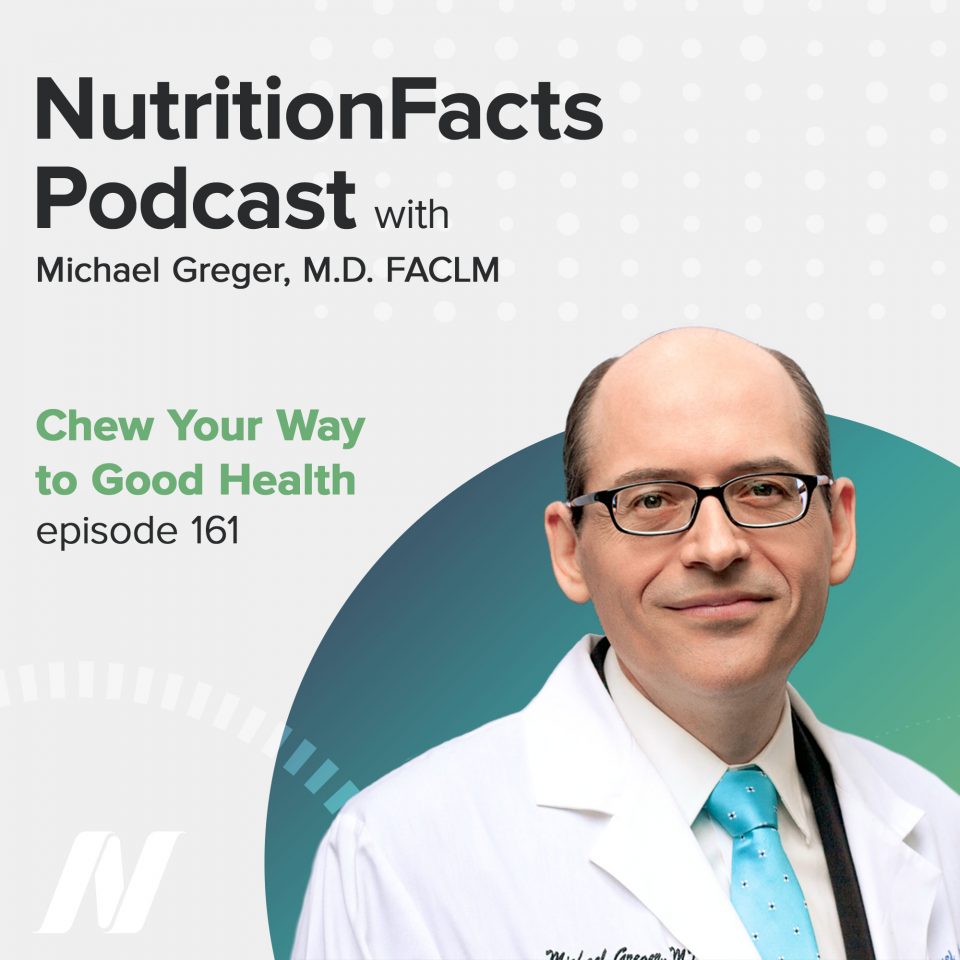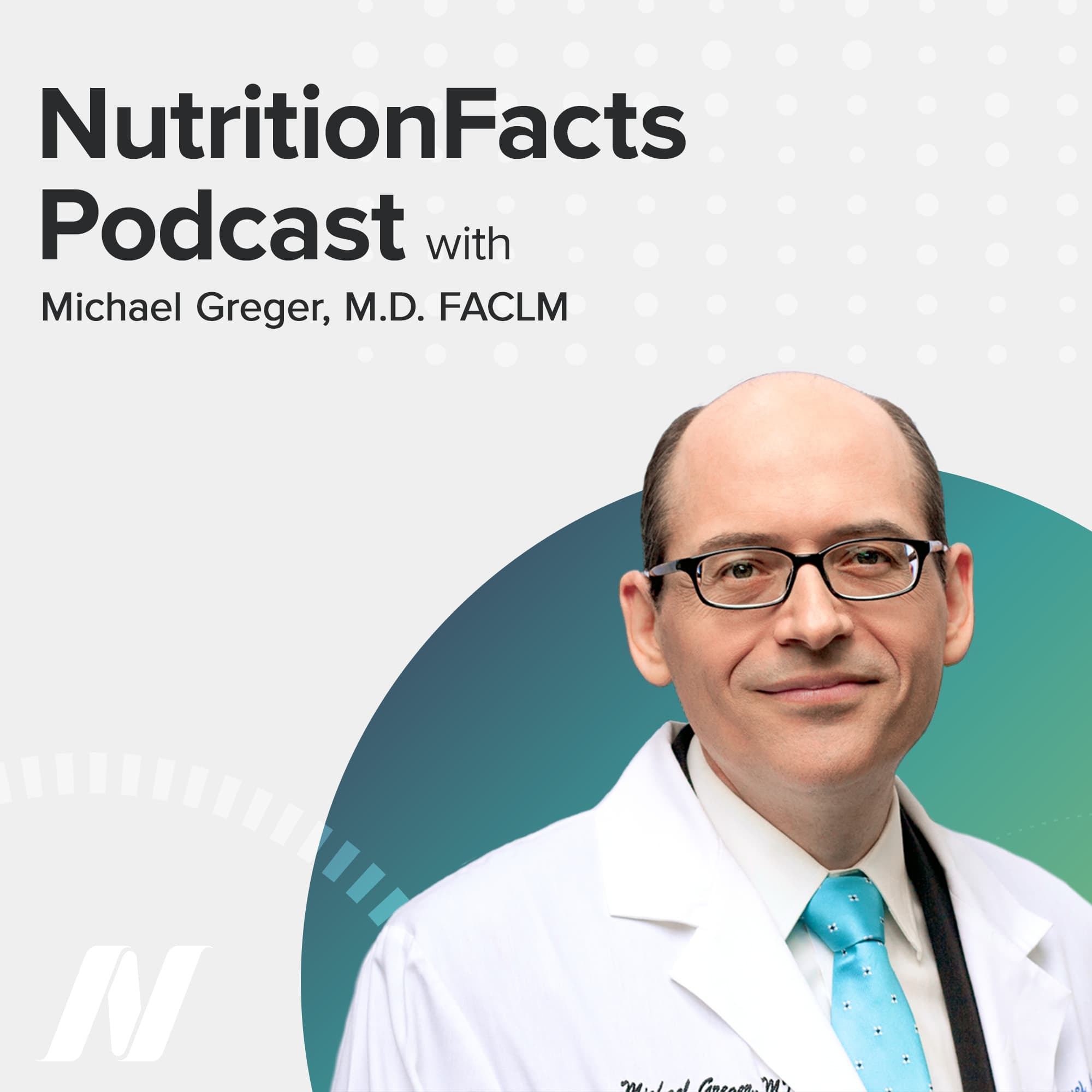There are lots of things we want to do in life. Climb a mountain, write a song, watch our grandchildren grow up. But guess what? We can’t do any of those things if we don’t have our health.
Welcome to the Nutrition Facts Podcast. I’m your host Dr. Michael Greger. And I’m here to bring you evidence-based research that takes the mystery out of the best way to live a healthier, longer life.
Today on the show we examine the effects of gum chewing on hunger and appetite.
“Horace Fletcher,” proclaimed one of his obituaries in 1919, “taught the world to chew.” Also known as the “Great Masticator,” Fletcher was a health reformer who popularized the idea of chewing each mouthful more than 32 times (“once for every tooth”). It wasn’t put to the test, though, until nearly a century later. People were told to eat pasta until they were “comfortably full,” but were randomized to either “Chew each mouthful 10 times” or “Chew each mouthful 35 times” before swallowing. The subjects were told it was a study about “the effects of chewing on mood”, but that was just a ruse. What the researchers really wanted to know is whether “prolonged chewing reduced food intake.” And, those who chewed more felt full earlier than those who chewed less, such that they ended up eating about a third of a cup less pasta overall.
If chewing in some way suppresses your appetite, what about chewing gum as a weight loss strategy? An article entitled “Benefits of Chewing Gum” suggested as much, but it was written by “the executive director of The Wrigley Science Institute.” Let’s see what the science says.
Big Gum likes to point to this letter published in The New England Journal of Medicine back in 1999. Mayo Clinic researchers claimed gum chewing could burn 11 calories an hour. Critics pointed to the fact that they didn’t really test typical gum chewing, instead chewing the equivalent of four sticks of gum “at a very rapid cadence.” Specifically, they were “instructed to chew at a frequency of precisely 100 Hz” for 12 minutes. That seemed to burn 2.2 calories, hence potentially 11 calories an hour.
One might have had more confidence in the Mayo scientists’ conclusion had they not lacked a fundamental understanding of basic units. A hundred Hz would mean 100 chews per second which would be a very rapid cadence indeed. If the 11 calories an hour is true, though, that might mean you could burn more calories actively chewing gum sitting in a chair than you would not-chewing-gum upright at a standing desk.
But chewing one small piece of gum at your own pace may only burn about three calories an hour, which would approximate the calorie content of sugar-free gum itself. But chewing off the calories of a piece of sugar-sweetened gum might take all day. OKay but, what about the purported appetite-suppressing effect of all that chewing?
The results from studies on the effects of gum chewing on hunger are all over the place. Some studies show decreased appetite, some showed no effect, and one even showed significantly increased hunger after gum chewing among women. The more important question, though, is: are there any changes in subsequent calorie intake? Again, the findings are mixed. One study even found that while gum chewing didn’t much impact M&M consumption, it did appear to decrease the consumption of healthy snacks. Ah, but they used mint gum, and the healthy snacks included mandarin orange slices; so, this may have just been an orange-juice-after-tooth-brushing effect.
It can take an hour before the residual taste effect of mint toothpaste dissipates. This is bad if it cuts your fruit intake, but what about harnessing this power against Pringles? An international group of researchers had people eat Pringles potato chips for 12 minutes, interrupting them every three minutes to swish with a menthol mouthwash. Compared to those in the control groups (swishing with water or nothing at all) the minty mouthwash group cut their consumption 29 percent. The researchers conclude: “if a consumer finds themselves snacking on too many chips, one potential strategy could be intervening by having a peppermint tea, menthol-flavoured chewing gum, or brushing their teeth to slow down or stop snacking.”
In our next story, we discover if extra chewing is effective in suppressing appetite, and what about chewing gum as a weight loss strategy?
Chewing gum may only burn about three calories an hour, but the calorie expenditure is not just your little jaw muscles at work. For some reason, gum chewing revs up your heart rate, as much as an extra 12 beats per minute after chewing two sticks of gum. It also works while walking, increasing your heart rate by about three beats more per minute. And proving scientifically that people can indeed walk and chew gum at the same time.
But does this translate into weight loss?
Researchers at the University of Buffalo asked study participants to go for weeks chewing gum before every single eating occasion, or chew no gum at all. On the gum-chewing weeks, they didn’t just have to chew gum before each meal, but before each snack or even each drink that had any calories in it. This may have been too much for folks, so they actually ended up eating on fewer occasions, switching from four meals a day on average down closer to three. But they ended up eating more calories at each of those fewer meals; and so, had no overall significant change in calorie intake and, no surprise, had “no change” in weight.
University of Alabama researchers tried a different tack, randomizing people to chew gum after and between meals. After two months, compared to those randomized to avoid gum entirely, no improvements were noted in weight, BMI, or waist circumference. But what about those few studies that suggested gum chewing had an appetite-suppressing effect? In this study, people ate 68 fewer calories of pasta at lunch after 20 minutes of gum chewing. Yeah, but other studies showed differently.
Whenever there are conflicting findings, instead of just throwing your hands up, it can be useful to try to tease out any study differences that could have potentially account for the disparate results. The obvious consideration is funding source. This was a publicly funded study, but that failed Alabama weight loss study was funded by a gum company. So, the outcomes are not necessarily predetermined.
Different types of gum using different sweeteners may have contributed to the diversity of findings. That one study showing gum chewing instead actually may increase appetite, for example, was done with aspartame-sweetened gum. People reported feeling hungrier after chewing the sweetened gum, not only compared to no gum, but compared to chewing the same gum with no added aspartame. True, not a single randomized controlled trial has ever shown a benefit to gum chewing, but they’ve all used gum containing artificial sweeteners.
There was a landmark study that showed that “sip size” matters. Have people drink at the same rate, but give them a sip every two seconds or a quadruple-sized gulp every eight seconds, and the smaller sip group won out, satiating after about one-and-a-half cups, compared to two cups when taking larger swigs. This is thought to be because of increased “oro-sensory exposure.” Your brain is picking up the more frequent pulses of flavor and calories. But repeat the experiment with an artificially-sweetened diet drink, and the effect appears to be blunted. So, maybe a different type of gum would have a different effect? The positive pasta study was performed using gum mainly sweetened with sorbitol, a sweet compound found naturally in foods like prunes but like prunes, can have a laxative effect.
Case reports like this: “An air stewardess with puzzling diarrhea” unveil what can happen when you eat 60 sticks of sorbitol-sweetened sugar-free gum a day. Another was entitled: “Severe weight loss caused by chewing gum,” but not in a good way. A 21-year-old woman ended up malnourished after suffering up to a dozen bouts of diarrhea a day for eight months due to the 30 grams of sorbitol she was getting chewing sugar-free gum and candies every day. Most people suffer gas and bloating at 10 grams of sorbitol a day, which is about eight sticks of sorbitol-sweetened gum, and at 20 grams, most get cramps and diarrhea. So, you want to be careful how much you eat.
The bottom line is that we have no good science showing gum-chewing results in weight loss. Could that be because the studies used artificial sweeteners that “may have counteracted” any benefits? Could be, but “the most obvious” explanation for the results to date “is that chewing gum simply is not an efficacious weight-loss strategy” and that’s coming from researchers funded by the gum company itself.
We would love it if you could share with us your stories about reinventing your health through evidence-based nutrition. Go to NutritionFacts.org/testimonials. We may share it on our social media to help inspire others.
To see any graphs, charts, graphics, images, or studies mentioned here, please go to the Nutrition Facts Podcast landing page. There you’ll find all the detailed information you need, plus links to all of the sources we cite for each of these topics.
For recipes, check out my “How Not to Die Cookbook.” It’s beautifully designed, with more than 100 recipes for delicious and nutritious meals. All the proceeds I receive from the sales of my books all goes to charity.
NutritionFacts.org is a nonprofit, science-based public service, where you can sign up for free daily updates on the latest in nutrition research via bite-sized videos and articles.
Everything on the website is free. There’s no ads, no corporate sponsorship. It’s strictly non-commercial. I’m not selling anything. I just put it up as a public service, as a labor of love, as a tribute to my grandmother, whose own life was saved with evidence based nutrition.
Thanks for listening to Nutrition Facts. I’m your host, Dr. Michael Greger.

 Previous Podcast
Previous Podcast Next Podcast
Next Podcast